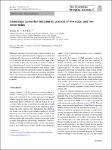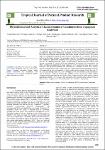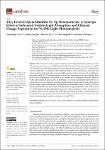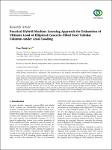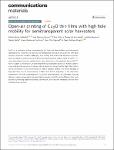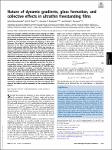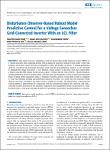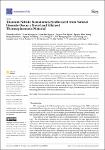Search
Author
- Anh-Tuan Le (14)
- Quan-Hoang Vuong (14)
- Ngo, Xuan Dinh (11)
- Tuan Q. Do (10)
- next >
Subject
- Electrospinning (7)
- Nanoparticles (6)
- Machine learning (5)
- Compound droplet (4)
- next >
Date issued
Has File(s)
Search Results
Inspired by an interesting counterexample to the cosmic no-hair conjecture found in a supergravity-motivated model recently, we propose a multi-field extension, in which two scalar fields are allowed to non-minimally couple to two vector fields, respectively. This model is shown to admit an exact Bianchi type I power-law solution. Furthermore, stability analysis based on the dynamical system method is performed to show that this anisotropic solution is indeed stable and attractive if both scalar fields are canonical. Nevertheless, if one of the two scalar fields is phantom then the corresponding anisotropic power-law inflation turns unstable as expected. |
Fagopyrum esculentum (buckwheat) is an annual herb that is commonly cultivated in Vietnam for ornamental and food purposes. Previous studies also indicated the medicinal potential of the plant due to its high content of bioactive compounds. However, every year, more than 300 ha of buckwheat cultivation has been discarded after flower festival in North Vietnam. The present study was conducted to clarify the main chemical constituents of F. esculentum aerial parts collected in Ha Giang, Vietnam. The investigation has led to the isolation and identification of nine compounds, specifically flavonoids (rutin, quercetin, quercetin 3-O-rhamnopyranoside, quercetin 3-O-galactopyranoside), lignan (isolariciresinol), phenylpropanoids linking with sucrose (lapathoside A, lapathoside D) and phyt... |
Logically, and by most common standards, academics would be pleased to be cited, considering it a form of recognition of their intellect. In return, especially those with high citation counts, such as Clarivate Analytics’ Highly Cited Researchers, can benefit through peer recognition, rewards, funding, securing a better position, or expanding a collaborative network. Despite known and untold benefits, one issue has not been discussed: the right to refuse to be cited or the right to refuse a citation. Academics might not want to be cited by papers published in truly predatory journals, papers with false authors, or sting papers with falsified elements that employ underhanded ethical tactics. Currently, academics generally have the freedom to select where they publish their findings a... |
This work reports on the synthesis, characterization, and photocatalytic performance of the TiO2 inverse opal nanostructure (IP-TiO2) and the IP-TiO2 modified by Ag nanoparticles (Ag@IP-TiO2). The IP-TiO2 is fabricated using polystyrene spheres as the template and TiCl4 as the precursor, and the Ag@IP-TiO2 is realized by photoreduction method. The morphological, structural, and optical properties of the materials are investigated by scanning electron microscopy, X-ray diffraction, ultraviolet–visible (UV-VIS) absorption spectroscopy, and photoluminescence spectroscopy. Their photocatalytic performances are studied by the degradation of rifampicin antibiotic under the visible-light irradiation generated by an LED lamp. The results demonstrate that the IP-TiO2 is composed of mesopores... |
In this study, a hybrid machine learning (ML) technique was proposed to predict the bearing capacity of elliptical CFST columns under axial load. The proposed model was Adaptive Neurofuzzy Inference System (ANFIS) combined with Real Coded Genetic Algorithm (RCGA), denoted as RCGA-ANFIS. The evaluation of the model was performed using the coefficient of determination (R2) and root mean square error (RMSE). The results showed that the RCGA-ANFIS (R2 = 0.974) was more reliable and effective than conventional gradient descent (GD) technique (R2 = 0.952). The accuracy of the present work was found superior to the results published in the literature (R2 = 0.776 or 0.768) when predicting the load capacity of elliptical CFST columns. Finally, sensitivity analysis showed that the thickness o... |
Cu2O is a promising p-type semiconductor for low-cost photovoltaics and transparent optoelectronics. However, low-cost and low-temperature fabrication of Cu2O films with good transport properties remains challenging, thus limiting their widespread adoption in devices. Here, we report Cu2O thin films of 20–80 nm thickness with hole mobility up to 92 cm2V−1s−1 using atmospheric-pressure spatial atomic layer deposition at temperatures below 260 °C, from a copper (I) hexafluoro-2,4-pentanedionate cyclooctadiene precursor. Raman spectroscopy indicates the presence of copper split vacancies and shows that the high hole mobility can be correlated to a low concentration of shallow acceptor defects. The optical bandgap of deposited films can be tuned between 2.08 eV and 2.5 eV, depending on ... |
Nature of dynamic gradients, glass formation, and collective effects in ultrathin freestanding films Molecular, polymeric, colloidal, and other classes of liquids can exhibit very large, spatially heterogeneous alterations of their dynamics and glass transition temperature when confined to nanoscale domains. Considerable progress has been made in understanding the related problem of near-interface relaxation and diffusion in thick films. However, the origin of “nanoconfinement effects” on the glassy dynamics of thin films, where gradients from different interfaces interact and genuine collective finite size effects may emerge, remains a longstanding open question. Here, we combine molecular dynamics simulations, probing 5 decades of relaxation, and the Elastically Cooperative Nonlinear Langevin Equation (ECNLE) theory, addressing 14 decades in timescale, to establish a microscopic ... |
This paper proposes a disturbance observer-based robust model predictive control (MPC) for a voltage sensorless grid-connected inverter with an inductive-capacitive-inductive (LCL) filter. A full-state estimator and a grid voltage observer are designed to reduce the number of sensors. A lumped disturbance observer, considering the parameter mismatch along with the grid impedance variation, is also designed to eliminate the steady-state error. A cost function, which consists of the error state and control input, is employed in the MPC design. Based on the Lyapunov stability, the full-state observer, voltage estimation, lumped disturbance observer, and the robust controller gains are obtained by solving an optimization problem based on linear matrix inequality (LMI). A frequency respo... |
This work presents a thorough study on the early stage of copper electrodeposition from a choline chloride-urea deep eutectic solvent (DES). Determination of possible species in DES containing Cu2+ ions as the electrolytes has been performed using UV-Vis measurements. Kinetic and thermodynamic aspects of copper electrodeposition on glassy carbon electrode from DES were thoroughly investigated using cyclic voltammetry (CV) and chronoamperometry (CA). Both results from CA and CV have demonstrated that the copper electrodeposition could be performed directly from DES containing a small amount of water by the single potentiostatic step technique. Theoretical approach confirmed that the direct electronucleation of copper nanoparticles in the DES can be described by a model with two contr... |
Nanostructures of titanium nitride (TiN) have recently been considered as a new class of plasmonic materials that have been utilized in many solar energy applications. This work presents the synthesis of a novel nanostructure of TiN that has a nanodonut shape from natural ilmenite ore using a low-cost and bulk method. The TiN nanodonuts exhibit strong and spectrally broad localized surface plasmon resonance absorption in the visible region centered at 560 nm, which is well suited for thermoplasmonic applications as a nanoscale heat source. The heat generation is investigated by water evaporation experiments under simulated solar light, demonstrating excellent solar light harvesting performance of the nanodonut structure. |

